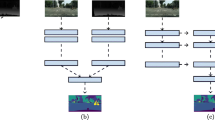Abstract
Semantic scene understanding of unstructured environments is a highly challenging task for robots operating in the real world. Deep Convolutional Neural Network architectures define the state of the art in various segmentation tasks. So far, researchers have focused on segmentation with RGB data. In this paper, we study the use of multispectral and multimodal images for semantic segmentation and develop fusion architectures that learn from RGB, Near-InfraRed channels, and depth data. We introduce a first-of-its-kind multispectral segmentation benchmark that contains 15, 000 images and 366 pixel-wise ground truth annotations of unstructured forest environments. We identify new data augmentation strategies that enable training of very deep models using relatively small datasets. We show that our UpNet architecture exceeds the state of the art both qualitatively and quantitatively on our benchmark. In addition, we present experimental results for segmentation under challenging real-world conditions. Benchmark and demo are publicly available at http://deepscene.cs.uni-freiburg.de.
This work has partly been supported by the European Commission under FP7-267686-LIFENAV and FP7-610603-EUROPA2.
Access this chapter
Tax calculation will be finalised at checkout
Purchases are for personal use only
Similar content being viewed by others
References
Badrinarayanan, V., et al.: SegNet: a deep convolutional encoder-decoder architecture for image segmentation. arXiv preprint (2015). arXiv:1511.00561
Bradley, D.M., et al.: Vegetation detection for mobile robot navigation. Technical report CMU-RI-TR-05-12, Carnegie Mellon University (2004)
Eitel, A., et al.: Multimodal deep learning for robust RGB-D object recognition. In: International Conference on Intelligent Robots and Systems (2015)
Fischler, M.A., Bolles, R.C.: Random sample consensus: a paradigm for model fitting with applications to image analysis. Comm. ACM 24(6), 381–395 (1981)
He, K., Zhang, X., Ren, S., Sun, J.: Deep residual learning for image recognition. arXiv preprint (2015). arXiv:1512.03385
Hirschmüller, H.: Accurate and efficient stereo processing by semi-global matching and mutual information. In: CVPR (2005)
Huete, A., Justice, C.O., van Leeuwen, W.J.D.: MODIS vegetation index (MOD 13), Algorithm Theoretical Basis Document (ATBD), Version 3.0, p. 129 (1999)
Jia, Y., et al.: Caffe: convolutional architecture for fast feature embedding. arXiv preprint (2014). arXiv:1408.5093
Liu, F., Shen, C., Lin, G.: Deep convolutional neural fields for depth estimation from a single image (2014). arXiv:1411.6387
Liu, W., et al.: ParseNet: looking wider to see better. preprint (2015). arXiv:1506.04579
Long, J., Shelhamer, E., Darrell, T.: Fully convolutional networks for semantic segmentation. In: CVPR, November 2015
Lowe, D.: Distinctive image features from scale-invariant keypoints. Int. J. Comput. Vis. 60(2), 91–110 (2004)
Ronneberger, O., Fischer, P., Brox, T.: U-Net: convolutional networks for biomedical image segmentation. In: MICCAI (2015)
Oliveira, G.L., Burgard, W., Brox, T.: Efficient deep methods for monocular road segmentation. In: International Conference on Intelligent Robots and Systems (2016)
Ren, S., He, K., Girshick, R., Sun, J.: Faster R-CNN: towards real-time object detection with region proposal networks. In: NIPS (2015)
Schwarz, M., Schulz, H., Behnke, S.: RGB-D object recognition and pose estimation based on pre-trained convolutional neural network features. In: ICRA (2015)
Sermanet, P., et al.: Overfeat: integrated recognition, localization and detection using convolutional networks. arXiv preprint (2013). arXiv:1312.6229
Socher, R., et al.: Convolutional-recursive deep learning for 3D object classification. In: NIPS, vol. 25 (2012)
Simonyan, K., Zisserman, A.: Very deep convolutional networks for large-scale image recognition (2014). arXiv:1409.1556
Thrun, S., Montemerlo, M., Dahlkamp, H., et al.: Stanley: the robot that won the DARPA grand challenge. JFR 23(9), 661–692 (2006)
Author information
Authors and Affiliations
Corresponding author
Editor information
Editors and Affiliations
Rights and permissions
Copyright information
© 2017 Springer International Publishing AG
About this paper
Cite this paper
Valada, A., Oliveira, G.L., Brox, T., Burgard, W. (2017). Deep Multispectral Semantic Scene Understanding of Forested Environments Using Multimodal Fusion. In: Kulić, D., Nakamura, Y., Khatib, O., Venture, G. (eds) 2016 International Symposium on Experimental Robotics. ISER 2016. Springer Proceedings in Advanced Robotics, vol 1. Springer, Cham. https://doi.org/10.1007/978-3-319-50115-4_41
Download citation
DOI: https://doi.org/10.1007/978-3-319-50115-4_41
Published:
Publisher Name: Springer, Cham
Print ISBN: 978-3-319-50114-7
Online ISBN: 978-3-319-50115-4
eBook Packages: EngineeringEngineering (R0)




